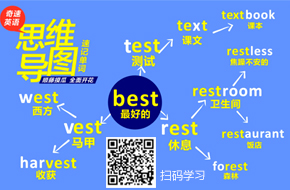动词时态和语态是英语语法的“骨架”,直接影响句子的准确性和表意清晰度。很多人觉得时态复杂、语态难辨,其实只要抓住“动作的时间”“动作的状态”“动作的主被动关系”这三个核心,就能逐一攻克。奇速英语AI伴督学结合具体场景和易错点,详细拆解,帮你真正做到“学透会用”。
一、动词时态:从“时间+状态”双维度拆解
时态=时间(过去/现在/将来)+状态(一般/进行/完成/完成进行)。高中阶段核心时态共10种,每种都有明确的“适用场景”和“形式特征”,记住这些就能避免混淆。
(一)一般时态:动作的“常态”“习惯”或“一次性发生”
核心特点:不强调动作的“正在进行”或“是否完成”,只说明动作发生的时间。
- 一般现在时(do/does)
- 适用场景:
1. 经常性、习惯性动作:I walk to school every morning.(每天都这样,是习惯)
2. 客观真理、自然规律:Water boils at 100℃.(不受时间影响的事实)
3. 现阶段的状态:She works in a hospital.(目前的工作状态,可能持续很久)
- 易错点:第三人称单数要加“s”(如he plays),否定句用“don’t/doesn’t + 动词原形”。
- 时间标志:always, usually, often, sometimes, every day/week等。
- 一般过去时(did)
- 适用场景:
1. 过去某一具体时间发生的动作:He left for Beijing yesterday.(昨天发生,已结束)
2. 过去的习惯:I used to play basketball after school.(过去常做,现在不做了)
- 易错点:不规则动词的过去式要特殊记(如go→went,eat→ate),否定句用“didn’t + 动词原形”。
- 时间标志:yesterday, last night/week, in 2019, just now等。
- 一般将来时(will do / be going to do)
- 适用场景:
1. will do:临时决定或客观将来:—The phone is ringing. —I’ll answer it.(临时决定接电话)
2. be going to do:计划好的事或有迹象要发生:We’re going to visit the museum tomorrow.(计划好的);Look at the dark clouds—it’s going to rain.(有迹象)
- 易错点:“will”无人称变化,“be going to”要根据主语变am/is/are。
- 时间标志:tomorrow, next week, in the future, soon等。
(二)进行时态:动作“正在发生”,强调“过程”
核心特点:动作在某一时间点或时间段内“正在进行”,可能未完成。
- 现在进行时(am/is/are + doing)
- 适用场景:
1. 此刻正在做的事:They are having a meeting now.(现在这个时间点正在开会)
2. 现阶段临时进行的事:I’m reading a novel these days.(这几天一直在读,可能还没读完)
- 易错点:有些动词(如like, know, have表“拥有”时)一般不用于进行时,因为它们是“状态动词”,不是“动作动词”。
- 时间标志:now, at the moment, these days, look! listen!(提示此刻正在发生)。
- 过去进行时(was/were + doing)
- 适用场景:
1. 过去某一时刻正在做的事:I was watching TV at 8 p.m. last night.(昨晚8点那个时刻正在看电视)
2. 过去两个动作同时进行:While my mom was cooking, I was doing homework.(妈妈做饭时,我在写作业)
3. 过去的“背景动作”被另一个短动作打断:I was walking home when it started to rain.(走路是背景,下雨是突然发生的短动作)
- 时间标志:at 9 o’clock last Sunday, when/while引导的时间状语从句。
(三)完成时态:动作“已完成”,强调“结果”或“影响”
核心特点:动作发生在某个时间之前,且对该时间点有影响。
- 现在完成时(have/has + done)
- 适用场景:
1. 过去发生的动作,对现在有影响:I have lost my wallet.(结果是“现在没钱”)
2. 动作从过去持续到现在:She has lived in Shanghai for 5 years.(从5年前到现在一直住那)
- 易错点:不能和“具体过去时间”(如yesterday)连用,因为它强调“与现在的联系”;延续性动词(如live, work)可与for/since连用,短暂性动词(如die, leave)需转换(如die→be dead)。
- 时间标志:already(肯定句), yet(否定/疑问句), ever, never, for + 时间段, since + 时间点/句子(用一般过去时)。
- 过去完成时(had + done)
- 适用场景:表示“过去的过去”,即动作发生在另一个过去动作之前:When I got to the station, the train had left.(火车离开在“我到达”之前,都是过去)
- 易错点:必须有“过去的参照点”(如一般过去时的动作),否则不能用。
- 时间标志:by + 过去时间(如by last year), before + 过去动作, 宾语从句中(如He said he had seen the movie.)。
- 将来完成时(will have + done)
- 适用场景:到将来某一时间,动作已完成:By next month, I will have finished the project.(到下个月,项目已经完成)
- 时间标志:by + 将来时间(如by 2025, by the end of this year)。
(四)完成进行时态:动作“持续进行”且“未中断”
核心特点:强调动作从过去开始,一直持续到某个时间,且可能还在进行,侧重“持续的过程”。
- 现在完成进行时(have/has + been + doing)
- 适用场景:He has been studying English for 3 hours.(从3小时前开始,现在可能还在学,强调“一直在学,没停”)
- 与现在完成时的区别:现在完成时强调“完成的结果”(如He has studied English for 3 hours. 可能已经结束),完成进行时强调“持续的过程”。
二、动词语态:主动与被动的“转换逻辑”
语态体现“动作与主语的关系”:主动语态(主语是动作发出者),被动语态(主语是动作承受者)。被动语态的核心是“be + 过去分词”,关键是“根据时态变be动词,过去分词不变”。
(一)被动语态的基本用法
- 当动作的承受者更重要时:The Mona Lisa was painted by Da Vinci.(重点是“《蒙娜丽莎》”,而非达芬奇)
- 不知道动作发出者时:My bike was stolen last night.(不知道谁偷的)
- 避免提及动作发出者时:Mistakes should be corrected in time.(不想说“谁应该纠正错误”)
(二)各时态的被动语态结构(高频必记)
时态 主动结构 被动结构 例句
一般现在时 do/does am/is/are + done English is spoken in many countries.
一般过去时 did was/were + done The window was broken yesterday.
一般将来时 will do will be + done The work will be finished soon.
现在进行时 am/is/are doing am/is/are being done The bridge is being built now.
现在完成时 have/has done have/has been done The problem has been solved.
过去完成时 had done had been done The task had been completed by then.
(三)被动语态的“特殊情况”(易错点)
1. 带双宾语的动词:如give, teach, show(sb. sth. 或 sth. to sb.),被动时可将“人”或“物”作主语。
主动:He gave me a pen.
被动:I was given a pen. 或 A pen was given to me.
2. 带宾语补足语的动词:被动时补足语保留在动词后。
主动:We call him Tom.
被动:He is called Tom.
3. 不及物动词无被动:如happen, appear, rise, die(这些动词没有“承受者”)。
错误:The accident was happened.
正确:The accident happened.
4. 短语动词的被动:将短语视为整体,不能漏掉介词/副词。
主动:They look after the children well.
被动:The children are looked after well.
三、实战技巧:3步搞定时态与语态
1. 判断时间:根据句意或时间标志,确定动作发生在过去、现在还是将来。
例:“She ______ (live) here since 2010.” → 时间标志“since 2010”→ 现在完成时 → has lived。
2. 判断状态:动作是“一般常态”“正在进行”“已完成”还是“持续进行”?
例:“At 7 p.m. yesterday, I ______ (cook).” → 过去某一时刻→过去进行时→was cooking。
3. 判断主被动:主语是动作的发出者还是承受者?
例:“The letter ______ (send) yesterday.” → 主语“letter”是“send”的承受者→被动语态,过去时→was sent。
时态和语态的核心是“为表意服务”,而非死记规则。平时做题时多思考“这个动作到底发生在什么时候?处于什么状态?谁是动作的主角?”,慢慢就能形成“语感直觉”。结合例句反复练习,你会发现:原来时态和语态,真的可以一篇吃透!
2025中考英语时态语态真题
1.(2025·云南·中考真题)The film Ne Zha 2 is worth seeing. I ________ it three times so far.
A. have seen B. saw C. will see D. see
2.(2025·福建·中考真题)Since last year, our school ________ free breakfasts to students in need.
A. has provided B. provided C. will provide D. provides
3.(2025·江西·中考真题)—Lisa, your shoes are dirty.
—Oh, just leave them there, Mum. I ______ them with my clothes.
A. washed B. will wash C. am washing D. wash
4.(2025·江西·中考真题)It ______ heavily. We are going to get all wet walking outside.
A. is raining B. rains C. rained D. was raining
5.(2025·天津·中考真题)The mobile phone ________ when I was making a cake with my mother.
A. rang B. rings C. was ringing D. is ringing
6.(2025·黑龙江绥化·中考真题)On the Dragon Boat Festival, my mother cooked delicious zongzi and ________ them on the plate.
A. laid B. lay C. lain D. lies
7.(2025·甘肃金昌·中考真题)—Cindy, my sunglasses are on the floor and they are broken. What happened?
—I ______ in the kitchen then.
A. cook B. was cooking C. have cooked D. will cook
8.(2025·甘肃白银·中考真题)Look! There ________ a notebook and three keys on the desk.
A. is B. was C. are D. were
9.(2025·江苏连云港·中考真题)As people pay more and more attention to cultural treasures, the industry of ancient book repairing ________ fast in China now.
A. developed B. was developing C. is developing D. will develop
10.(2025·黑龙江·中考真题)When Li Lei came into the room, his friends ________ for his birthday party.
A. prepared B. are preparing C. were preparing D. prepare
11.(2025·黑龙江·中考真题)—How long has she ________ the science book? I want to borrow it from her.
A. buy B. had C. bought D. borrowing
12.(2025·黑龙江绥化·中考真题)Lots of tourists from the southern part of China ________ Harbin twice.
A. have gone to B. have been in C. have been to D. has been to
13.(2025·江苏扬州·中考真题)During Guyu, the temperature usually ________ a lot and rain increases.
A. rise B. rises C. rose D. will rise
14.(2025·安徽·中考真题)—The robots ________ each other to the finish line.
—How amazing!
A. are racing B. raced C. will race D. race
15.(2025·云南·中考真题)The 12th World Games ________ in Chengdu in August, 2025.
A. will be held B. is held C. was held D. has been held
2025高考英语时态语态试题
1.(2025年全国一卷)“The players’ personalities ______ (reveal) during the game, and one’s weaknesses are exposed to the opponent,” she adds. “A decent winner always ______ (try) to beat the opponent by no more than one or two points as a gesture (姿态) of respect for the other side. ”
2.(2025年全国二卷)The “sunshine scent (香味)” of freshly sunned clothes ______ (be) one of them.
3.(2025年全国二卷)If you’ve never experienced the “sunshine scent” from a sheet or shirt ______ (leave) to sun for a day, well, you’re missing out on one of life’s wonders.
4.(2025年1月浙江首考)The concept______ (be) certainly not new — men have been renting good suits for decades — but for female shoppers, it is just taking off.
5.(2025年1月浙江首考)By the time you brushed your teeth, you ______ (make) several decisions even without noticing. Some choices are quick, while others take more thought. Usually, better outcomes ______ (achieve) through a thorough understanding of strategies like risk tolerance.
6.(2025年北京高考)Before he ______ (graduate) from high school, he had already been admitted to a famous university.
7.(2025年天津高考)The old temple which ______ (date) back to the 12th century is being repaired now.
8.(2025年山东高考)A new bridge ______ (build) across the river in the coming year.
9.(2025年广东高考)When I entered the room, I found that the window ______ (break) and the computer was missing.
10.(2025年四川高考)This kind of medicine ______ (prove) to be very effective in treating the disease so far.
答案详解
2025中考英语时态语态真题答案详解
1. A。“so far”是现在完成时的标志词,结构为have/has+过去分词,主语是I ,所以用have seen。
2. A。“Since last year”表示从过去持续到现在,用现在完成时,主语“our school”是第三人称单数,所以用has provided。
3. B。根据语境,这里表示还没洗,是将来的动作,用一般将来时,will+动词原形,所以选will wash。
4. A。“We are going to get all wet walking outside”表明说话时正在下雨,用现在进行时,be+动词现在分词,it作主语,be动词用is ,所以是is raining。
5. A。“when I was making a cake with my mother”表示过去某个时间点,手机响是短暂动作,用一般过去时,ring的过去式是rang。
6. A。and连接并列谓语,前面cooked是一般过去时,这里也用一般过去时,lay“放置”的过去式是laid。
7. B。“then”指太阳镜坏的时候,当时正在做饭,用过去进行时,was/were+动词现在分词,主语是I,用was cooking。
8. A。“Look!”表明是现在的情况,用一般现在时,there be句型遵循就近原则,“a notebook”是单数,所以用is。
9. C。“now”表明是现在正在发展,用现在进行时,be+动词现在分词,主语是“the industry of ancient book repairing”,be动词用is,所以是is developing。
10. C。“When Li Lei came into the room”表示过去的时间点,当时朋友们正在为生日聚会做准备,用过去进行时,were+动词现在分词 ,所以是were preparing。
11. B。“How long”表示时间段,现在完成时中要和延续性动词连用,buy是短暂性动词,have是其延续性形式,过去分词是had。
12. C。“have gone to”表示去了某地还没回来;“have been in”表示待在某地;“have been to”表示去过某地,这里表示去过哈尔滨两次,主语“Lots of tourists”是复数,所以用have been to。
13. B。“usually”是一般现在时的标志词,主语“the temperature”是第三人称单数,动词用rises。
14. A。根据语境,机器人正在比赛,用现在进行时,are+动词现在分词,所以是are racing。
15. A。“in August, 2025”是将来的时间,“运动会被举办”用一般将来时的被动语态,will be+过去分词,hold的过去分词是held,所以是will be held。
高考英语时态语态试题答案详解
1. are revealed;tries。第一空,描述一般事实用一般现在时,主语“personalities”与“reveal”是被动关系,用一般现在时的被动语态,主语是复数,be动词用are,所以填are revealed;第二空,根据“always”可知是一般现在时,主语“a decent winner”是第三人称单数,所以谓语动词try用tries。
2. is。描述一般事实用一般现在时,主语“The ‘sunshine scent (香味)’ of freshly sunned clothes”是第三人称单数,be动词用is。
3. left。句中已有谓语“have experienced” ,这里用非谓语动词,“a sheet or shirt”和“leave”是逻辑上的动宾关系,用过去分词left作后置定语。
4. is。句子陈述客观事实用一般现在时,主语“The concept”是单数,所以be动词用is。
5. had made;are achieved。第一空,“By the time you brushed your teeth”是过去完成时的标志,在过去某个时间点之前已经完成的动作,用had made;第二空,“Usually”表明是一般现在时,“outcomes”和“achieve”是被动关系,用一般现在时的被动语态,主语是复数,be动词用are,所以填are achieved。
6. graduated。before引导时间状语从句,根据主句“had already been admitted”是过去完成时,从句用一般过去时,graduate的过去式是graduated。
7. dates。“date back to”表示“追溯到”,常用一般现在时,主语“temple”是单数,所以用dates。
8. will be built。“in the coming year”表示将来,“桥被建造”用一般将来时的被动语态,will be+过去分词,build的过去分词是built。
9. was broken。“When I entered the room”是过去的时间,“窗户被打破”用一般过去时的被动语态,主语“window”是单数,be动词用was ,break的过去分词是broken,所以是was broken。
10. has proved。“so far”是现在完成时的标志词,主语“This kind of medicine”是单数,所以用has proved。





